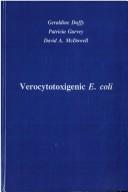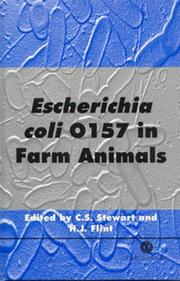| Listing 1 - 10 of 20 | << page >> |
Sort by
|

ISBN: 0917678524 Year: 2001 Publisher: Trumbull (Conn.) : Food and nutrition press,
Abstract | Keywords | Export | Availability | Bookmark
 Loading...
Loading...Choose an application
- Reference Manager
- EndNote
- RefWorks (Direct export to RefWorks)
Bacteriology. --- Escherichia coli O157:H7. --- Escherichia coli infections.
Periodical
Year: 2009 Publisher: [Washington, D.C.] : U.S. Dept. of Agriculture, Agricultural Research Service
Abstract | Keywords | Export | Availability | Bookmark
 Loading...
Loading...Choose an application
- Reference Manager
- EndNote
- RefWorks (Direct export to RefWorks)
Lettuce --- Escherichia coli O157:H7 --- Microbial contamination --- Sampling --- California
Periodical
Year: 2009 Publisher: [Washington, D.C.] : U.S. Dept. of Agriculture, Agricultural Research Service
Abstract | Keywords | Export | Availability | Bookmark
 Loading...
Loading...Choose an application
- Reference Manager
- EndNote
- RefWorks (Direct export to RefWorks)
Lettuce --- Escherichia coli O157:H7 --- Microbial contamination --- Sampling
Periodical
Year: 2009 Publisher: [Washington, D.C.] : U.S. Dept. of Agriculture, Agricultural Research Service
Abstract | Keywords | Export | Availability | Bookmark
 Loading...
Loading...Choose an application
- Reference Manager
- EndNote
- RefWorks (Direct export to RefWorks)
Escherichia coli O157:H7 --- Pathogenic bacteria --- Host-bacteria relationships --- Acidification

ISBN: 085199332X Year: 1999 Publisher: Wallingford : CABI publishing,
Abstract | Keywords | Export | Availability | Bookmark
 Loading...
Loading...Choose an application
- Reference Manager
- EndNote
- RefWorks (Direct export to RefWorks)
Escherichia coli O157:H7. --- Escherichia coli infections in animals. --- Escherichia coli infections. --- Escherichia coli infections --- Escherichia coli infections in animals --- Escherichia coli O157:H7 --- EHEC (Bacterium) --- Enterohemorrhagic Escherichia coli --- Escherichia coli O157 --- Escherichia coli --- Bacterial diseases in animals --- Veterinary gastroenterology --- Colibacillosis --- Gram-negative bacterial infections --- ESCHERICHIA COLI O157 --- ESCHERICHIA COLI INFECTIONS --- CATTLE --- CATTLE DISEASES --- STOMACH, RUMINANT --- ABATTOIRS --- GENETICS --- PATHOGENICITY --- VETERINARY
Dissertation
ISBN: 9789085046745 9085046742 Year: 2007 Publisher: Netherlands : Wageningen University,
Abstract | Keywords | Export | Availability | Bookmark
 Loading...
Loading...Choose an application
- Reference Manager
- EndNote
- RefWorks (Direct export to RefWorks)
In recent years the number of enteric disease outbreaks has increased, partly due to an increase in human pathogenic bacteria associated with fresh produce. The use of manure for production of vegetables, e.g. lettuce, contributes significantly to the risk of contamination of fresh produce. Enteric pathogens like Salmonella associated with manure can come in close contact with plants like lettuce, and a better understanding of the interaction between lettuce and Salmonella enterica serovars during lettuce cultivation is necessary to be able to take preventive actions to reduce the risk for human health. This thesis describes a comparison of different molecular methods to detect Salmonella enterica (invA-gene) or Escherichia coli O157:H7 (stx-1, stx-2 and eae-gene) with respect to sensitivity, precision and accuracy. The detection and quantification methods were improved by the addition of a general internal amplification control. The methods enable a reduction in assay time to two days to test food samples, compared to five days required for the standardized procedures. To improve detection of S. enterica serovars from environmental substrates, five DNA extraction methods were evaluated with respect to DNA extraction efficiency from soil, manure and compost. Inclusion of an internal procedural control permitted a more accurate quantification of S. enterica after DNA extraction and amplification and reduced the possibility of false-negatives. This thesis also describes the physiological and molecular interaction between S. enterica serovars and lettuce. Investigation of the localization of S. Dublin on/in lettuce plants revealed the presence of significant populations on the surface and inside the plants. Next to this physiological response, there were clear differential gene expression profiles between non-colonized and colonized lettuce plants based on transcriptome analysis by cDNA-AFLP. Functional grouping of the expressed genes indicated a correlation between colonization of the plants and an increase in expressed pathogenicity-related genes. Moreover, a differential interaction of S. Typhimurium, S. Enteritidis, S. Dublin, S. Newport and S. Montevideo with lettuce cultivars Cancan, Nelly and Tamburo was found, in terms of prevalence and degree of endophytic colonization of lettuce by the S. enterica serovars. Besides a significant interaction, significant differences among serovars, but not among lettuce cultivars, were obtained when lettuce was grown under axenic conditions. When grown on soil, each evaluated Salmonella serovar was able to colonize lettuce epiphytically, but to a lower extent than on axenically grown plants. Only S. Dublin was able to colonize the plants endophytically when these were grown on contaminated soil. In addition, the active movement of S. enterica serovars towards lettuce roots is presented. Micro-array analyses with DNA extracted from a broth culture of S. Typhimurium with or without exudates identified genes of S. enterica serovars that were induced by root exudates. These genes imply a relation with a sugar-like carbon source. From this study different plant and microbial factors that influence the colonization efficiency of S. enterica serovars have been identified. The serovar and cultivar, but indirectly also the rhizosphere and the endophytic microflora of lettuce were most influential with respect to the risk of colonization and thus the risk for human health.
Salmonella --- Escherichia coli O157:H7 --- Lettuce --- Foodborne diseases. --- Detection. --- Detection. --- Microbiology.
Periodical
Year: 2007 Publisher: Washington, D.C. : U.S. Dept. of Agriculture, Agricultural Research Service
Abstract | Keywords | Export | Availability | Bookmark
 Loading...
Loading...Choose an application
- Reference Manager
- EndNote
- RefWorks (Direct export to RefWorks)
Escherichia coli O157:H7 --- Virulence (Microbiology) --- Pathogenic microorganisms --- Lettuce --- Spinach --- Genetic aspects --- Diseases and pests
Periodical
Year: 2008 Publisher: [Washington, D.C.] : U.S. Dept. of Agriculture, Agricultural Research Service
Abstract | Keywords | Export | Availability | Bookmark
 Loading...
Loading...Choose an application
- Reference Manager
- EndNote
- RefWorks (Direct export to RefWorks)
Escherichia coli O157:H7 --- Microbial contamination --- Farm produce --- Agricultural processing --- Prevention --- Microbiology --- Health aspects --- Produits agricoles --- Microbiologie
Book
Year: 2004 Publisher: [Washington, D.C.] : U.S. Dept. of Agriculture, Food Safety and Inspection Service, Office of Public Affairs, Education and Outreach,
Abstract | Keywords | Export | Availability | Bookmark
 Loading...
Loading...Choose an application
- Reference Manager
- EndNote
- RefWorks (Direct export to RefWorks)
Book
ISBN: 155581879X 9781555818791 9781555818784 1555818781 Year: 2015 Publisher: Washington, DC
Abstract | Keywords | Export | Availability | Bookmark
 Loading...
Loading...Choose an application
- Reference Manager
- EndNote
- RefWorks (Direct export to RefWorks)
Escherichia coli infections. --- Escherichia coli O157:H7. --- Verocytotoxins. --- Hemolytic-uremic syndrome. --- Gasser syndrome --- Gasser's syndrome --- HUS (Disease) --- Uremic-hemolytic syndrome --- Acute renal failure --- Blood platelet disorders --- Hemolytic anemia --- Syndromes --- Uremia --- Shiga-like toxins --- SLT (Bacterial toxin) --- VT (Bacterial toxin) --- Enterotoxins --- EHEC (Bacterium) --- Enterohemorrhagic Escherichia coli --- Escherichia coli O157 --- Escherichia coli --- Colibacillosis --- Gram-negative bacterial infections
| Listing 1 - 10 of 20 | << page >> |
Sort by
|

 Search
Search Feedback
Feedback About UniCat
About UniCat  Help
Help News
News